 |
Please note : There are lots of large pictures on this page
that may take some time to download if using a dial up connection.
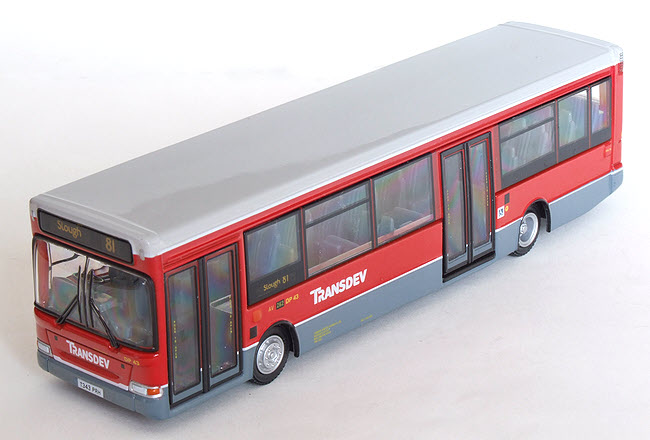
36601 Transdev Dennis Dart SLF Plaxton Pointer 2
|
A Brief History
The Dennis Dart
The Dennis Dart dates backs to the late 1980's, it was developed to meet a demand for vehicles larger than the van based minibuses which had become popular following the deregulation of bus services in the mid 80's.
The first 8.5 metre vehicles appeared with Duple built Dartline bodywork, Plaxton's acquired Duple not long after the launch of this design but promptly sold the Dartline rights to Carlyle.
However Plaxton decided to develop their own design of bodywork for the Dart which by now was available in longer versions, the new Pointer range was launched by Plaxton in early 1991.
The original Dart had a step entrance design and EFE added a 9.8 metre version of this bus to it's range (206 Series) in 1996, the forty odd releases of this model to date certainly prove just how popular this combination was with operators across the UK.
The move to low floor easy access buses particularly in London resulted in Dennis producing a Super Low Floor (SLF) version of the Dart in 1995, Plaxton modified their Pointer design to produce a flat floor version, the mark I version of this was based on the original design but was rather short lived being replaced by the restyled Pointer 2 design in 1997. This combination of chassis & bodywork was produced in a variety of lengths ranging from 8.5 to 11.3 metres and has proved the most popular of all the designs, the pointer 2 quickly became the single deck vehicle of choice for a vast range of operators both large & small across the UK.
Over 11,000 Darts were produced before production finally ceased in 2007, the Dart was superseded by Alexander Dennis Enviro200 range of buses.
|
|
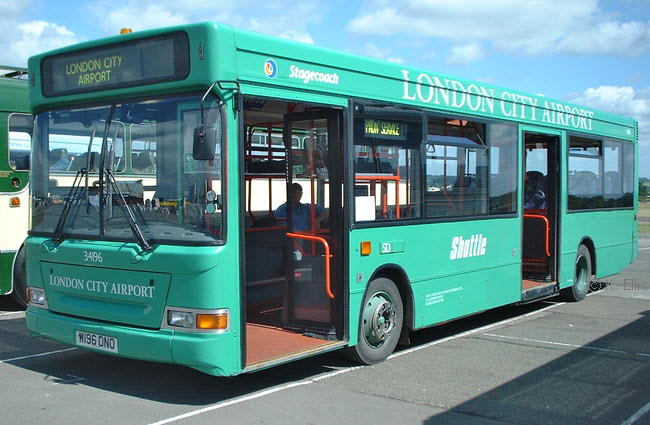
Stagecoach London dual door 10.1 metre Dennis Dart SLF Plaxton Pointer 2 34196 (W196WNO)
A picture of the actual Transdev bus modelled by EFE can be found HERE
|
| The Model
The model depicts a 10.7 metre version of the bus and it's worth pointing out that this is the second time EFE have issued this particular model.
Back in 1999 EFE released a dual door version of the Pointer 2 SLF in New World First Bus livery. The model was produced by NWFB and was subsequently made available to members of EFE's Subscription Service, the EFE models were allocated the EFE series code 26901 suggesting that EFE were hoping to release further UK versions of the casting, sadly this wasn't to be as licensing issues prevented EFE using this particular casting.
The new model however bears a very close resemblance to the earlier NWFB one and side by side it really is a case of spot the difference, however that said there are indeed a number of improvements and modifications over the earlier version.
Here I review the first release which depicts T343PRH (DP43) a dual door bus in the red & grey London livery used by Transdev's London United Busways division.
|
|
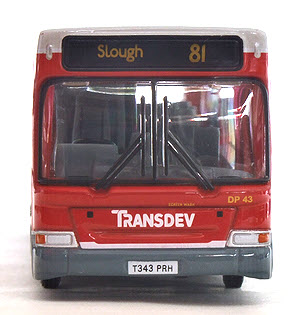 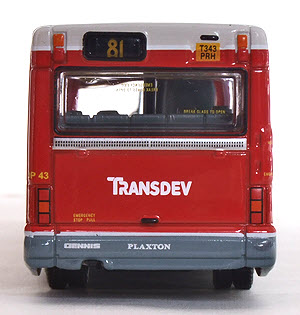


|
|
First impressions of the model are good, the front and rear end are nicely detailed and seem to capture Plaxton's design quite well, the destination displays have clear plastic inserts over the route information which is rather effective.
On the front the wiper blades are moulded onto the windscreen glazing and along with the edges of the screen are neatly picked out with black paint. The lights front and rear are all depicted using tampo printing on raised areas of the casting. Likewise the air intake grille on the rear above the engine cover is reproduced using tiny black dots on a silver background.
|
|
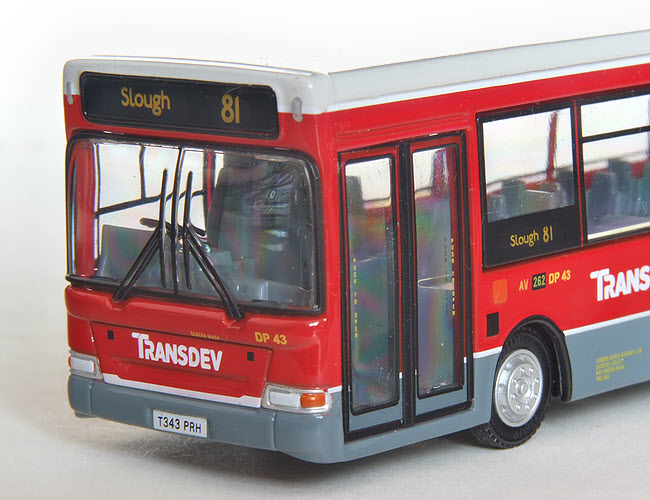
The glazed destinations work well and the windscreen wipers look convincing
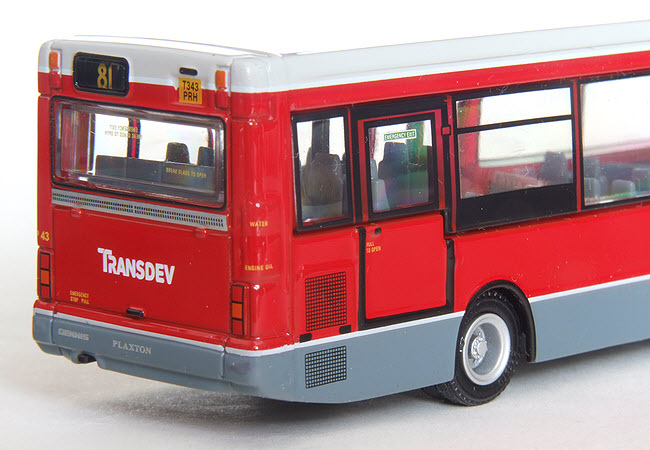
Note the various tampo printed decaling on the rear of this model. |
|
Moving onto the sides of the model, all the window glazing is produced using flat clear plastic inserts, these have all window detail tampo printed on them which should allow for alternative window arrangements.
Many Darts had all back window surrounds however EFE have correctly reproduced the red central area on the upright glazing bars, something that is correct on these particular London vehicles. It's a bit unfortunate therefore that the red paint used to achieve this detail is rather lacking opacity and pillars are somewhat transparent as a result.
|
|

The somewhat transparent red paint on the window pillars.
|
|
Staying with the window glazing this has a very slight tamper inwards towards the roof, this becomes more noticeable around the centre exit which appears to be out of line with the front doors as a result. The glazing should be vertical as depicted on the earlier NWFB model.
The doors themselves have moulded detailing and this is combined with tampo printing to produce a convincing appearance. One thing that would have improve them further would have been some sort of representation of high visibility yellow internal handrails, these again were tampo printed on the NWFB model.
The near side destination display is produced by printing the destination on the interior of the glazing and this method does give the desired effect.
Surprisingly the model doesn't have any mirrors and given that EFE have already managed to fit fairly decent plastic ones to the low floor Wright single deck buses this omission is somewhat disappointing.
Internally the seats are reproduced using a single light grey plastic seating block, the usual pair of black poles are present to hold the model together. One improvement over the NWFB version is that the drivers seat and internal dashboard panel have been raised up much higher which is more in keeping with the real vehicles.
The model also has a cream internal ceiling that includes some basic light and air vent detailing.
|
|
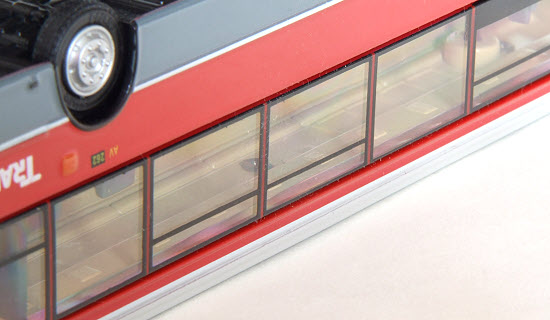
The model has internal ceiling detailing that includes lights & air vents.
|
|
The model has a fairly high level of external signage, these are all tampo printed and even the smallest are fully legible although you'll probably need a magnifying glass to confirm this! Items reproduced include the white Transdev fleet names, the small yellow legal lettering & various items indicating emergency exits and filler access points.
Focusing on the accuracy of the livery applied to this particular model it doesn't seem too far out, although there are a few differences, the main one is the position of the near side destination display at the bottom of the window, it should in fact be at the top, the lower white band should be positioned below the beading line rather than on it.
The fleet name lettering also looks a bit bolder than it should do and appears slightly oversized as a result.
Some other minor points which may or may not be correct include the position of the near side fleet number, this is usually positioned below the rear most side window and this is confirmed in all the pictures of the Transdev Darts I've managed to find. Likewise the lower white band between the headlights seems to be a feature that is present on some Transdev Pointers but not others.
|
|
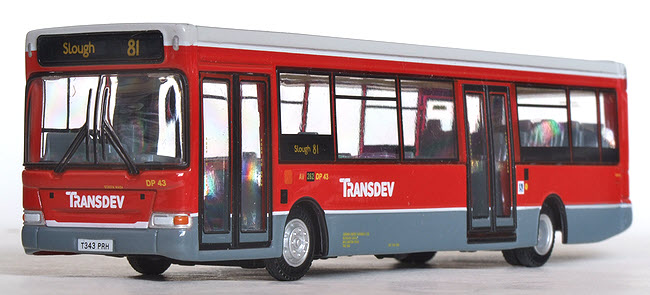
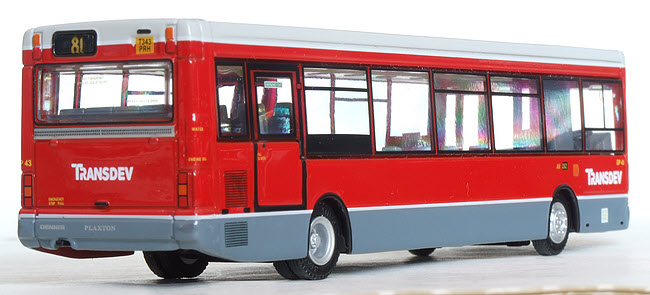
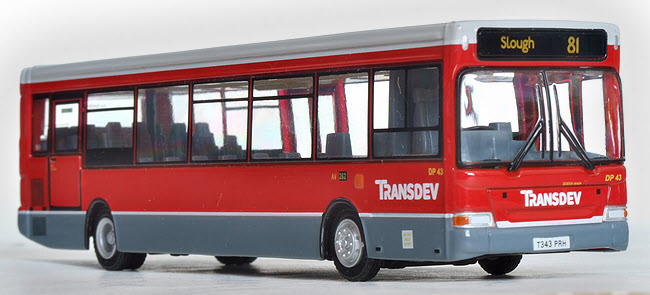
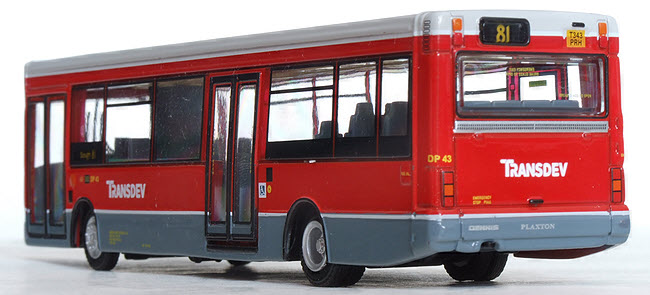
|
|
The roof is completely smooth with just a raised bead at the front and rear.
The single piece black plastic baseplate on the other hand contains some engine detail along with chassis supports and various air and fuel tanks.
|
|


|
|
I've got to say I rather like this model, it certainly captures the Pointer well, and when compared with the Corgi OOC offering it is a much more refined product, however there are some points that aren't quite right in my eyes, the front panel below the windscreen appears rather flat, the real vehicles seem to have a more rounded central section (see picture above).
|
|

A comparison, the OOC v EFE models
|
|
The wheels look to be inset too far into the wheel arches, this is particularly noticeable at the rear.
Even though it's only visible at certain angles the slight inward slant of the side glazing is also a rather disappointing feature.
Finally I can't help feeling that I won't be the only one disappointed by the lack mirrors and the failure to add any representation of the highly visible yellow door handrails.
It will be interesting to see what future releases EFE have planned, the Dart Pointers were certainly a popular combination and should on the face of it offer EFE plenty of scope for future liveries, however I do wonder if the 10.7 metre version modelled will limit the choice somewhat as it doesn't appear to have been one of the most popular variants with operators who by & large seem to have preferred the shorter wheelbase versions. |

The 1999 NWFB version and the new 2009 models side by side.
|
| Model Review Index |
|


















